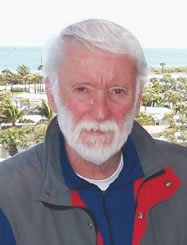
Richard Spademan was a true believer, a man who found a better way and shared it with the world. Born in 1933 in Detroit, he skied as a teenager at Boyne and attended college and medical school at the University of Michigan. As an intern, he designed and patented a successful vascular catheter (it’s still in wide use). Then, while doing his first year of residency in orthopedic surgery at Stanford, he worked at Tahoe Forest Hospital in Truckee. It was 1962. Squaw Valley was booming and skiers were just beginning to change over from cable bindings. He saw as many as 50 fractures a day on a busy weekend.
Spademan studied those patients. He learned that skiers didn’t know how to adjust their bindings, and that bindings were too complex anyway, with too many adjustments: for toe and heel height, forward pressure, release tension, and sometimes toe width. They didn’t release in enough directions, and not at all in sudden deceleration. And he began to build prototype bindings that might solve these problems. He zeroed in on the importance of fixing the boot under the tibial axis to reduce leverage, eliminated the toepiece to allow for deceleration release, and reduced the adjustments to a single screw.
Development took four years. Meanwhile, Spademan finished his residency and was named assistant professor of orthopedic surgery at Stanford. His catheter patent was paying nice royalties, which he invested in the binding. In 1966 he made a couple of hundred pairs, took a leave of absence from Stanford and visited every ski shop between Seattle and San Diego. “They thought I was nuts,” he recalled.
Eventually, some ski patrollers at Squaw and Boyne tried it out. After some adjustments to prevent early release, he had a viable product. He thought he’d license the design to a manufacturing company, as he’d done with the catheter, but the ski companies weren’t interested. In 1969 he set up a production line in a corrugated shed in Palo Alto, made 1,000 pairs, and went banging on doors again. This time he hired a couple of ski shop owners as consultants, and they introduced him to hundreds of other shop owners.
The freestyle movement wanted the binding. Bob Burns at The Ski Company had a light, soft mogul ski and liked the lightweight Spademan, especially in combination with the light Scott boot. By 1974 most championship-level pro freestylers were using the binding. Sales jumped from 10,000 pairs to 100,000 pairs in just three years. In particular, the binding became the lifeblood of the ski rental business. With only one adjustment, it was a huge timesaver, and was state-of-the-art safe. Spademan made plans to hire a professional manager and return to surgery.
The Spademan boot plate had to be screwed to a flat section of boot sole, and here Spademan ran into a problem. Boot designers, notably Chris Hanson, wanted to sculpt out the area under the arch. Working through the American Society for Testing and Materials, a compromise was struck: Most boot factories agreed to provide a flat mounting zone for the plate, and Spademan agreed to move the plate aft slightly. This required new tooling. In 1978, as his sales peaked, the outside machinist delivered Spademan’s molds several months late. He missed the pre-Christmas selling season, and sales plummeted.
The timing was dreadful. Salomon chose that year to introduce the 727. It had a ski brake and a big fat treadle to open the heel: it was the first true hands-free step-in binding. By 1983 Spademan, along with Besser, Burt and all the other plate binding companies, was gone. Dr. Spademan returned to surgery, becoming chief of orthopedics at the Stanford Medical Center. Before retiring in 1994, he held no fewer than 40 patents in skiing, running shoes, medical equipment and sailing gear.
That year he sailed off in his ketch Prophecy III for an around-the-world journey. In January of 2010, on arriving in Florida, he was diagnosed with an advanced cancer. Richard Spademan died on Dec. 19, 2010, of complications following cancer surgery. –Seth Masia

Comments
Spademan Bindings
Still Ski on my orange Olin "Freestyle Ballet Skis every year. What a Great inventor. I'm in my 50's now and have never had an injury from a twisting fall on them.
The thing that Dr. Spademan was trying to prevent.
Still Doing "Leg Breakers" and other things that should end you up in the ER.
Thank You Dr. Spademan
Add new comment